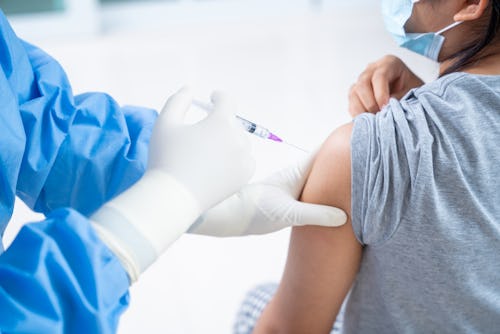
As a health journalist who’s closely followed the pandemic since its earliest days — back when we still wiped down our groceries — I hoped I wouldn’t need to write another version of the story I filed around this time last year. Back then, I sought to answer the question: What will the fall look like?
But thanks, in no small part, to the politicization of what is ultimately a public health crisis (as well as the highly contagious Delta variant), here we are. I interviewed medical experts about what we can expect in the coming months, including whether the number of hospitalizations and deaths will be as staggering as they were last autumn.
At this point, we’re no longer talking about an upcoming surge, according to Stanley Weiss, a professor of medicine and epidemiology at Rutgers New Jersey Medical School. “We’re already beginning to see a surge this summer,” he tells me. “How long this surge continues is going to depend upon many factors.”
The U.S. is seeing more than 100,000 cases on average for the first time since February, per the New York Times, in the winter conditions thought to worsen transmission and before vaccines were widely available. The newspaper noted that there's also been a steep increase in hospitalizations and deaths as Delta tears through communities. “I don’t know of any instance where we’ve had a variant of a virus so rapidly take over,” Weiss says.
Likewise, Jeff Pothof, the chief quality officer and emergency medicine doctor at UW Health in Madison, Wisconsin, believes that “over the next one, two, three months or so, we’ll continue to see cases rise” nationally, but he isn’t sure how high they’ll climb.
There will be regional variations, he says, consistent with what we’re already seeing. Areas where vaccination rates are high, like the Northeast, probably won’t have much of an increase, while those where vaccinations rates are low, like the South, “could have pretty substantial spikes and situations that mirror what they went through last fall.”
Although vaccination rates plateaued last month, they’ve begun creeping back up, the Times reported. According to the outlet, 50% of people in the U.S. have been fully vaccinated. The one bright spot is that because a lot of us are fully vaccinated, “the total pool of people who are risk for severe COVID and death is smaller” than it was last autumn, Pothoff says. As a result, we’ll probably see fewer hospitalizations and deaths. He adds that generally higher vaccination rates among older people, who are more susceptible to severe illness and dying of COVID-19, should also drive down these numbers.
“Over the next one, two, three months or so, we’ll continue to see cases rise.”
That also means that the average age of those who land in the hospital with COVID might be lower this time around, Pothof says. Again, the situation will probably differ by region. In those with low vaccination rates among those 65 and older, he notes that you probably won’t see that demographic shift.
But the number of hospitalizations and deaths will still be high enough to cause problems, Pothof says, particularly in the areas with the lowest vaccination rates. That’s where we’ll see overwhelmed hospitals, people in ICUs, and so on, he explains.

The confusion swirling around the shift in the CDC guidance is doing little to help subdue the current surge. The agency now recommends that everyone wear masks in indoor public settings in areas “with substantial or high transmission,” no matter their vaccination status, reversing the guidance it released in May, which exempted most fully vaccinated people from masking, in response to the rising tide of Delta.
That means for a few months now, fully vaccinated and — let’s be real — unvaccinated people alike were out and about without masking or social distancing, “and it felt really good,” Pothof says. (Indeed, various polls have shown that unvaccinated people are less likely to take these precautions than vaccinated people.)
“It’s always easier to not have something in the beginning than to have something and take it away,” Pothof explains. Put another way, it’s harder to ask people to go back to masking and the like after telling them they no longer had to than it would’ve been to ask them to just keep taking precautions.
What’s more, “it’s very hard for people to understand when things keeps changing on them,” and to understand how science and medicine alter their course based on the new data researchers uncover, says Weiss, who opposed the initial CDC guidance change in May, as did many other experts.
Pothof worries that the reversal of the guidance, combined with a misunderstanding of what vaccines are designed to do, could lead to hesitation to get the shot. “I think a lot of people approach the vaccines as a binary thing — either they work and I don’t get sick, or they don’t work and I get sick,” he says. “That’s just not the way vaccines work.”
No vaccine is perfect at preventing disease, he explains, and although the vaccines are still effective in preventing COVID-19 now that Delta’s arrived, what we should really evaluate is their ability to prevent hospitalization and death, which they do extremely well. As of July 26, only 6,587 breakthrough infections out of more than 163 million fully vaccinated people in the U.S. were reported to the CDC, or about .004%. Even that may be an overestimate, as FactCheck.org noted, since about a fourth of hospitalizations and deaths were documented as “asymptomatic or not related to COVID-19.” In contrast, unvaccinated people account for the vast majority of hospitalizations and deaths in the U.S.
But because of the widespread notion that vaccines should prevent COVID-19, period, “I think some people have this idea that, well, if I have to put a mask on and I’m vaccinated, why even get vaccinated in the first place?” Pothof says.
And if there are a lot of people who are unable or unwilling to get vaccinated, or take precautions like masking and social distancing, “we start running out of tools to slow the scope of this current surge,” Pothof says. “That’s why I think it’s likely that we’re going to see cases continue on, at least for a short time.” The irony is that this could lead to more people having close encounters with COVID — whether they get it themselves, or know someone who’s died or become seriously ill with it — which he says tends to motivate people to get vaccinated and take other public health recommendations seriously.
Weiss hopes that the U.S. greenlights vaccine boosters for older adults and people with weakened immune systems based on observations of these groups in Israel. Otherwise, “I’m very concerned that we’ll have, particularly people who are elderly , becoming ill and hospitalized,” he says. The FDA has yet to give the go-ahead to boosters for older adults but just authorized a booster of Pfizer and Moderna for immunocompromised people.
As with past spikes, though, we’re not powerless in the face of this one. Since it’s driven largely by the fact that not enough people are vaccinated, get the jab if you haven’t already, Pothof says. If you’re vaccinated, he suggests paying attention to the spread of the virus in your vicinity (which you can check here). If you’re in or near an area with substantial or high transmission, wear a mask especially if you’re indoors with a lot of people.
The immediate benefit of wearing a mask as a vaccinated person is to protect the vulnerable people around you who are at higher risk for scary outcomes if they do become infected, Pothof says. That includes not only people who choose not to get the vaccine, but those who can't because they’re under 12 or have certain medical conditions. Wearing a mask also protects vaccinated people with weakened immune systems, for whom the shots don't offer great immunity.
And while it may be easy to bristle at caring about people who simply refuse to get vaccinated, “it’s not quite that simple,” Pothof says. If the unvaccinated continue to spread the disease among each other, “at some point, they’re going to create the next variant that might be resistant to our vaccines, and then all of us who are vaccinated go back to the drawing board, too.” To stop the virus from flying much further through the Greek alphabet, we'll need to find it in ourselves to look out for one another, despite the rage and resentment.







